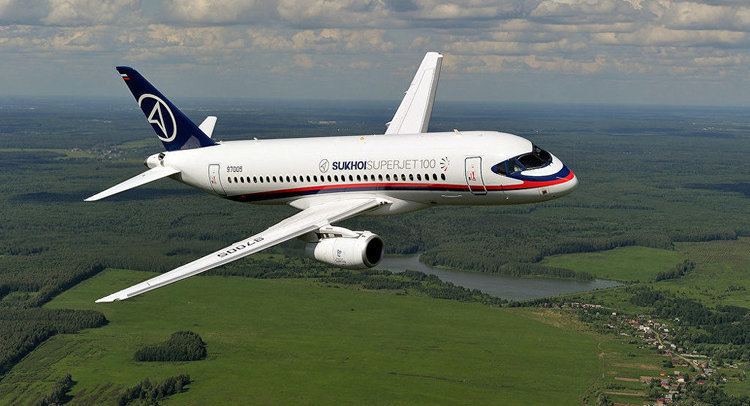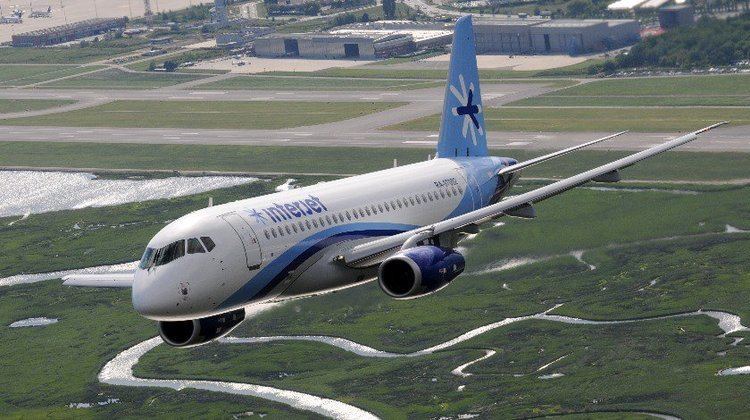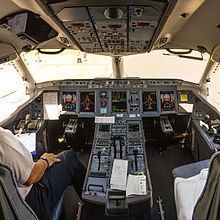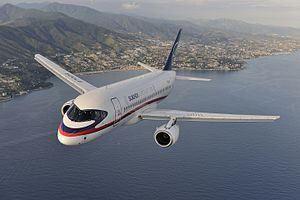Top speed 870 km/h Cruise speed 828 km/h Engine type PowerJet SaM146 | Wingspan 28 m Unit cost 35,000,000–35,000,000 USD First flight 2008 | |
 | ||
Manufacturers Sukhoi, Komsomolsk-on-Amur Aircraft Production Association | ||
Sukhoi superjet 100 ssj100 regional airliner at maks 4k passenger plane video
The Sukhoi Superjet 100 (Russian: Сухой Суперджет 100) is a modern fly-by-wire twin-engine regional jet with 8 (VIP) to 108 (all economy) passenger seats. With development initiated in 2000, the airliner was designed and spearheaded by Sukhoi, a division of the Russian civil aerospace company (UAC), in co-operation with several foreign partners. Its maiden flight was conducted on 19 May 2008. On 21 April 2011, the Superjet 100 undertook its first commercial passenger flight, on the Armavia route from Yerevan to Moscow.
Contents
- Sukhoi superjet 100 ssj100 regional airliner at maks 4k passenger plane video
- Aeroflot sukhoi superjet 100 business class moscow to kiev airclips full flight series
- Development
- Flight testing
- Certification
- Requirements
- Industry participation
- List of companies
- Overview
- Timeline
- Operational history
- Variants
- Specifications
- Accidents and incidents
- References

Designed to compete internationally with its An-148, Embraer E-Jet and Bombardier CSeries counterparts, the Superjet 100 claims substantially lower operating costs, at a lower purchase price of $35 million.

The final assembly of the Superjet 100 is done by Komsomolsk-on-Amur Aircraft Production Association. Its SaM-146 engines are designed and produced by the French-Russian PowerJet joint venture and the aircraft is marketed internationally by the Italian-Russian SuperJet International joint venture.

Aeroflot sukhoi superjet 100 business class moscow to kiev airclips full flight series
Development

Development of the Sukhoi Superjet 100 began in 2000. On 19 December 2002, Sukhoi Civil Aircraft and Boeing Commercial Airplanes signed a medium-term Cooperation Agreement to work together on the design. Boeing consultants had already been advising Sukhoi for a year. On 10 October 2003, the technical board of the project selected the suppliers of major subsystems. The project officially passed its third stage of development on 12 March 2004, meaning that Sukhoi could now start selling the Superjet 100 to customers. On 13 November 2004, the Superjet 100 passed the fourth stage of development, implying that the Superjet 100 was now ready for commencing of prototype production. In August 2005, a contract between the Russian government and Sukhoi was signed. Under the agreement, the Superjet 100 project would receive 7.9 billion rubles of research and development financing under the Federal Program titled Development of Civil Aviation in Russia in 2005–2009.
Flight testing
On 28 January 2007, the first SSJ was transported by an Antonov 124 from Komsomolsk-on-Amur to the city of Zhukovsky near Moscow for ground tests. A representative of Sukhoi Civil Aircraft announced on 13 November 2007, the completion of static tests necessary for conducting the first flight. The Superjet was unveiled at its official rollout at Komsomolsk-on-Amur Dzemgi Airport on 26 September 2007.
In February 2008, initial test runs of the SaM146 engine were successful. An Ilyushin Il-76 testbed, operated by the Gromov Flight Research Institute, was also used in the engine testing. On 19 May 2008, the first test flight of the Superjet took place from Dzemgi airport, at the Komsomolsk-on-Amur Aircraft Production Association.
In July 2008, testing continued successfully. By October 2008, the first stage of Sukhoi Superjet 100's factory-based flight testing program was successfully completed. The second SSJ100 prototype had also been flown and the certification process was started. In December 2008, the second of four SSJ100 prototypes SN95003 took to the skies. The aircraft performed standard stability and handling quality tests as well as systems checks in accordance with the first flight assignment. Flight test engineers and pilots were pleased with the overall performance of the second prototype.
The deliveries were first scheduled to begin in late 2008, and Sukhoi predicted that 3 units of all variations of the Superjet 100 would be delivered by the end of 2016. On 7 July 2008, Sukhoi officially confirmed that the original schedule was too optimistic, and first deliveries would begin in December 2009.
As of January 2009, the first two aircraft had completed over 80 flights, totaling around 2,300 hours in flight and ground tests. On 1 April 2009, two Superjet 100 prototypes, 95001 and 95003, successfully completed the first long-distance flight for this aircraft, covering a distance of 3,000 kilometers from Novosibirsk to Moscow. On 17 April 2009, EASA pilots performed the first test flights on the two prototypes. According to EASA pilot feedback, the aircraft was easy to fly. On 26 July 2009, the third of four SSJ100 prototypes (SN95004) flew.
At the Paris Air Show 2009, Malév Hungarian Airlines said that it would purchase 30 Superjets worth $1 billion, providing a welcome boost to sales as it made its international debut at the 2009 Paris Air Show.
As of June 2009, 13 aircraft were under construction with the first four scheduled to be handed over to clients by the end of 2010. After 2012, the company will build 70 Superjets per year. Armenian Armavia would receive the first two aircraft, followed by Aeroflot, which has ordered a total of 30 aircraft with an option for 15 more. Other customers include Russia's Avialeasing company, Swiss Ama Asset Management Advisor and Indonesian Kartika Airlines.
On 29 December 2009, United Aircraft Corporation head Alexei Fyodorov said that deliveries of the Superjet 100 have been indefinitely delayed because the engines were not ready. On 4 February 2010, the fourth prototype SSJ flew. Owing to delays in production of the engines, including quality problems at the NPO Saturn factory, it used the engines removed from the first prototype. On 28 May 2010, all engine tests necessary for certification were completed. The final trial was a simulation of an encounter with a flock of birds.
Flight management system (FMS) tests were completed on 19 November 2010. The FMS CMA-9000 was developed by Canada's Esterline CMC Electronics for the Thales avionics suite.
Certification
On 6 July 2010, Deputy Industry and Trade Minister Denis Manturov, who heads the commission to monitor the implementation of the Sukhoi Superjet program, wrote to Industry and Trade Minister Viktor Khristenko about the progress of the aircraft's certification in early June. Data from 28 May 2010 showed that the certification process was getting behind schedule with most of the problems related to the SaM146 engine, developed by PowerJet, which is a joint project between the Russian Saturn and the French Snecma. Work on its final design had been almost completed and certification was more than 90 percent completed, but problems remain, noted Manturov.
In September 2010, the CEO of SuperJet International said that certification was expected in November 2010. In October 2010, the Sukhoi Superjet 100 (SN95004) passed noise testing carried out under the auspices of Russian and European certification authorities (AR IAC and EASA respectively). On 4 November 2010, the first production Superjet (SN95007) intended for Armavia was test flown.
By November 2010, the SSJ test fleet had flown 2,245 hours during 948 flights.
On 21 December 2010, Superjet 100 passed emergency evacuation and interrupted takeoff tests at Ramenskoye Airport near Zhukovsky, near Moscow, under the supervision of the Interstate Aviation Committee Aviation Register (AR IAC) and the European Aviation Safety Agency (EASA). The first test required 98 volunteers of different age groups and five crew members to evacuate the aircraft in 90 seconds during an simulated emergency landing. They made it in 73 seconds. The interrupted takeoff test probed the wheels, tires and brakes at maximum possible braking speed, without a thrust reverser.
On 3 February 2011, the Interstate Aviation Committee (IAC IR) granted a Type Certificate for Sukhoi Superjet 100. The Type Certificate confirms compliance of the SSJ100 with the airworthiness regulations and it authorizes the commercial operation of the airliner.
On 3 February 2012, the European Aviation Safety Agency (EASA) issued Type Certificate A-176 for the Sukhoi Superjet 100 (model RRJ-95B), confirming that the aircraft complies with the EASA airworthiness and environmental requirements. The certification also makes it possible for airlines operating in countries using EASA rules to accept and operate the aircraft. The extensive validation program included several dedicated flight and ground tests.
Requirements
In the Russian domestic market, the Sukhoi Superjet 100 (SSJ) is intended to replace the aging Tupolev Tu-134 and Yakovlev Yak-42 aircraft. Internationally, the new Superjet 100 will compete against the Embraer E-Jets and the Bombardier CRJ programs. The SSJ aims for lower operating costs than its competitors for the price of $23–25 million. According to Sukhoi, ongoing certification tests confirmed that the aircraft's direct operating costs are 6–8% lower than those of its key competitor, the Embraer 190/195. In terms of total fuel burn per sector, the SSJ is on a par with the Antonov An-148 but can accommodate 22 more passengers.
The aircraft's design meets the specific requirements of airlines in Russia, the CIS, the United States and the EU, and conforms to the Aviation Rules AP-25, FAR-25, JAR-25 requirements and to the ground noise level requirements under ICAO Chapter 4 and FAR 36 Section 4 standards entering into force during 2006. From the beginning, the SSJ has been designed to meet all Western aviation standards.
The Superjet uses PowerJet SaM146 turbofan engines developed by PowerJet that provide 60 to 78 kilonewtons (13,000 to 18,000 lbf) of thrust. The noise and emissions levels satisfy the existing ICAO requirements.
Industry participation
The Superjet 100 has been described as the most important and successful civil aircraft program of the Russian aerospace industry. It enjoys considerable support from the Russian Ministry of Industry and Trade, which regards it as a top priority project. Excluding the SaM146 engine, development of the Superjet 100 cost about $1.4 billion, with 25% of this amount funded from the federal budget. The Superjet 100 is the first new civil non-amphibious jet aircraft developed in post-Soviet Russia.
Over 30 foreign partnership companies are involved in the project. Development, manufacturing and marketing of the aircraft's SaM146 jet engine is being done by the PowerJet company, a joint-venture between the French Snecma and Russia's NPO Saturn. SuperJet International, a joint venture between Alenia Aermacchi and Sukhoi is responsible for marketing in Europe, the Americas, Africa, Japan and Oceania.
The assembly line for all versions of the Superjet is located in the facilities of Komsomolsk-on-Amur Aircraft Production Association (KnAAPO) in the Russian Far East, while Novosibirsk Aircraft Production Association (NAPO) focuses on component production. The two companies have been heavily investing in upgrading of their facilities and were expected to produce 70 airframes by 2012.
List of companies
Overview
It is impossible to confirm the accuracy of the Superjet order backlog as the manufacturer does not provide up to date order information, and there have been no updates on many longstanding orders. Orders and deliveries:
Timeline
Data source
Operational history
The first production Sukhoi Superjet was delivered to Armavia on 19 April 2011. The handover ceremony was held at Zvartnots International Airport in Yerevan on the same day. The aircraft was named "Yuri Gagarin", after the first man to venture into space almost exactly 50 years before. Armavia planned to operate its Superjet 100 on flights between Yerevan, Sochi and Ukrainian cities, including Odessa and Simferopol. The airline had expected to receive its second Superjet in June 2011.
On 21 April 2011, the first commercial flight of Sukhoi Superjet 100 (SN 95007) by Armavia airline landed at Sheremetyevo International Airport, Moscow at 04:45 MSK (00:45 GMT), carrying 90 passengers from Zvartnots International Airport, Yerevan. The flight took about 2 hours and 55 minutes.
Armavia used the Airbus A319 on its Yerevan to Moscow (SVO) route and had a plan to switch to the Superjet 100. In August 2012 Armavia announced that they had returned both of its SSJ-100s to the manufacturer.
The president of United Aircraft Corporation and general director of Sukhoi Mikhail Pogosyan hailed the event as a key milestone for the Superjet 100 project, saying that it opened "a new stage of the program — the beginning of commercial operation and full-scale serial production."
The aircraft was put into commercial operation within an unprecedented short time after delivery. For the first week of service the SSJ-100 accumulated 24 flights, flying to Moscow, Athens, Donetsk, Aleppo, Tehran, Tel Aviv and Astrakhan. On 1 May, the Superjet made its first regular flight to Venice (2800 km, approx 3:45-minute flight).
In March 2012, the deputy chief engineer of the Department of Aviation and Technical Support of "Aeroflot" Constantine Mohniit revealed in the Russian daily newspaper Vedomosti, that Aeroflot was asking Sukhoi for compensation since the six Superjet 100s it operates are in the air only 3.9 hours/day on average instead of the standard 8 to 9 hours. Breakdowns "... were caused by failures due to technical problems and delayed delivery of parts."
In February 2013, SCA stated in a press release that such problems are usual in newly operational and recently introduced airliners and minimized the claims.
At the end of October 2013, Interjet confirmed outstanding results in terms of operations. As of 31 October, the two Interjet SSJ100 have completed almost 600 flight hours, over 580 flight cycles during their commercial operations, with an average daily usage of 9.74 block hours, and a dispatch reliability of 99.03%. Dispatch reliability of Interjet's fleet of seven SSJ100 increased to 99.7% as of June 2014.
On 16 December 2012, Mikhail Baghdasarov, owner of bankrupt Armavia, stated that both of its ordered airplanes had been returned to Sukhoi Civil Aircraft company. He was also quoted as saying "that the SSJ-100 is not operated by the company anymore, Sukhoi Civil Aircraft has possession of the jet, and Armavia had decided not to receive any aircraft." Armavia's website did not show that it is not operating Sukhoi Superjet 100s as of February 2013. However it ceased operations in March 2013
On 12 September 2014 Interjet started regular passenger flights to the U.S. on the Monterrey, Mexico (MTY) – San Antonio, Texas (SAT) route. The Mexican air carrier also currently operates the aircraft in scheduled service between Monterrey and Houston George Bush Intercontinental Airport (IAH).
On 2 June 2016 at approximately 18:30 the first SSJ100 for CityJet landed at Dublin Airport. This represented the first delivery of a new aircraft, of any type, for CityJet.
On 24 December 2016, the Russian aviation regulatory agency grounded six SSJ100s operating in Russia after metal fatigue was found in a tail component of an aircraft operated by IrAero, leading Sukhoi to begin inspections of the entire in-service SSJ100 fleet.
All SSJ100s were inspected by SCA on 27, December. Following the results of the inspection, the defect is not of a systemic nature and can be eliminated within a few days. The replacement of nodes on the aircraft with the defect identified(5 Aeroflot and 1 IrAero) will be completed by late January. Examination has confirmed that the issue is not a critical situation: the node features a multi-level redundant structure and has a safety margin which is more than twice the operational loads. All Mexican SSJ 100 were also inspected.
Variants
The three variants were originally called the RRJ-60, RRJ-75 and RRJ-95, with the numbers designating the average passenger capacity of each type. However, with the renaming of the project to Superjet 100 (or SSJ100 for short), the RRJ-75 was re-labelled the Superjet 100/75, while the RRJ-95 became known as the Superjet 100/95. The smallest variants were postponed, and efforts are currently concentrating on the Superjet 100/95. The Long Range variant is about to be certified, with a VIP-variant based on SSJ100/95LR to follow.
In 2005, Aeroflot ordered 30 Sukhoi Superjet 100 aircraft with 98 seats in one class. Later, the airline decided to upgrade the avionics (FMS and weather radar) and modify the aircraft arrangement with 87 seats in two class, and extra cabin crew seat, lavatory and galley. To avoid delivery delays, the first 10 SSJ100 have the original “light” specification and the followers were updated (“full”). In the first half of 2014 Sukhoi began to replace in Aeroflot the “light” aircraft by “full” version. The last “full” version was delivered in June 2014, the “light” aircraft are operated by other Russian airlines.
The center section of the SSJ100 could be stretched for 115 passengers. This section could be reused for the 130-seat (90 to 160) Superjet NG with a composite wing derived from the MS-21, PW1000G geared turbofans and production starting in 2019-2020. A stretch with 12 more seats to reach 120 with a longer central fuselage, larger wings but the same engines and tail is planned for introduction in 2020.
Specifications
Sources: SuperJet International.
